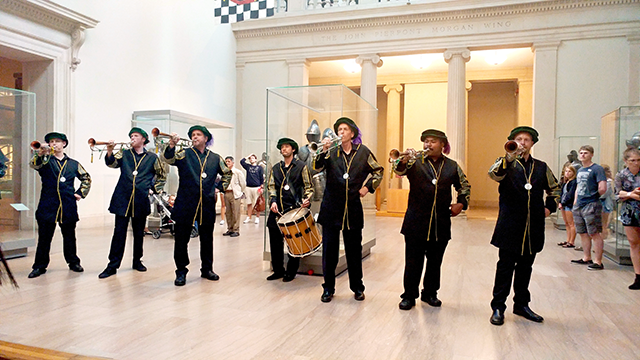
Led by HSU Music Professor Gil Cline, students Kevin Blake, Ryan Blake, Andrew Henderson, Charlie McClung and community member Chris Cox performed in the Arms and Armory gallery at the Metropolitan Museum of Art in New York City for the 2017 Historic Brass Society Symposium, which took place July 13-16. The society is an international music organization that champions brass music from antiquity and the Biblical period to the present. The society’s purview encompasses the history, music, literature and performance practice of early brass instruments, including the natural trumpet.
“The Consort von Humboldt turned in a superb performance. A great balance of excellent musicianship and fun that clearly connected with the audience,” said Bradley Strauchen-Scherer, Associate Curator of Musical Instruments at the Metropolitan Museum of Art.
Leading brass educators and musicians from the U.S., Canada, Europe, and Australia gathered at New York University for four days of lectures, discussions, and performances. Trumpet Consort von Humboldt was one of only two representatives—and the only performing group—from the West Coast.
This was not Humboldt-based consort’s first time performing at the symposium; the group was a hit when it performed at the last HBS Symposium in 2012 also in New York. Trumpet Consort von Humboldt is one of just a handful of university-based brass conservancy groups.
Lacking tuning vents, natural trumpets are significantly different from their modern day counterparts. The trumpets were first developed in the 1600s to be played for royalty and at special occasions like civic and military events. The valveless instrument’s tubing is usually 8 feet long, creating a timbre that is richer than today’s garden-variety trumpet and not as loud.
Without the vents, considerable skill is required to play a natural trumpet. Equally important is the player’s posture, where the left hand is kept at his or her side and the feet are arranged similar to the fourth position in ballet.
Learn more about the world of natural trumpets at magazine.humboldt.edu.